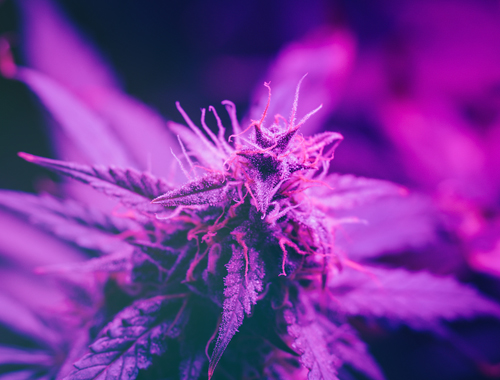
31 Oct Let’s Transform the Market for Energy Efficient Indoor Cannabis Cultivation
 BY MADDIE SLIGH, D+R INTERNATIONAL
BY MADDIE SLIGH, D+R INTERNATIONAL
Growing cannabis indoors is an energy intense process. As the number of states legalizing medical and recreational marijuana increases, the energy footprint increases as well. A 2017 survey conducted by New Frontier Data found that cannabis companies consume about 1.1 million megawatt hours of electricity per year, which is the amount of energy it would take to power 92,500 homes. To date, 33 states and the District of Columbia have legalized medical marijuana and 11 states and the District of Columbia have legalized recreational marijuana use. Although cannabis is not federally legal in the United States, it is increasingly contributing to the country’s energy footprint.
Energy consumption in cannabis grow facilities can be divided into three main categories: lighting, ventilation/dehumidification, and air conditioning. Lighting, which contributes to approximately a third of total carbon dioxide emissions from indoor cannabis facilities, is still largely generated by high intensity discharge (HID) lamps. In addition, growers typically provide light to their plants between 18 and 24 hours per day. Contrary to popular belief, LED lighting is very sparsely used in indoor agriculture facilities throughout the US and Canada even though LEDs are the most energy efficient lighting option on the market. In fact, according to the US Department of Energy, if all horticulture lighting today was converted to LED’s, there would be an energy savings of 40%. With heat inherently produced from HID lamps and the excessive moisture present in an indoor agriculture facility comes a need for dehumidification and air conditioning. While these processes are less energy intensive than lighting, they still contribute 27% and 19%, respectively, to overall carbon dioxide emissions.
Various utilities across the country have started to incentivize energy efficiency in grow facilities, but grower participation has been low for a variety of reasons. To name a few:
- The market has supported resale prices that cover growers’ energy costs
- Growers generally focus their attention on plant science
- Growers do not view utilities as natural partners
- LED technology is only customized for plant growth by a handful of lighting manufacturers.
The lack of grower participation in utility programs was captured by a 2018 survey of growers in Oregon and Washington conducted by the Northwest Power and Conservation Council where they found that only 10% of survey participants were contacted by their local utility. Expanding on this, research from the Southwest Energy Efficiency Project found that Xcel Energy, Puget Sound Energy, and Energy Trust of Oregon, all operating in states where the recreational market has driven down cannabis prices, have each only completed between 70 and 100 incentive projects with growers. This is significant because as cannabis prices decrease, the energy prices have largely remained constant.
With the need for increased efficiency and minimal involvement from the utilities thus far, implementing an informed market transformation strategy is the best way to overcome the varied obstacles. Industry experts have identified two major opportunities for market intervention. First, utilities need to know the baseline energy usage for cannabis production in the various building types that are used to grow cannabis. The Resource Innovation Institute (RII), a nonprofit organization focused on energy efficiency in the indoor agriculture industry, offers the Cannabis PowerScore to help growers benchmark their energy consumption and inform decisions on their indoor facilities’ energy use.
Cannabis growers need more education on how to assess energy capacity and how to budget and design facilities to be energy efficient. RII and the Energy Trust of Oregon have partnered in the past to host workshops on the subject. Additional outreach could reduce grower’s skepticism of LEDs and increase education about how to access energy efficiency incentives. Home grow operations are specifically a huge opportunity for research and education on efficient technologies as there are few regulations for these operations. Energy Trust of Oregon conducted research on home grow operations in 2018, but additional research on both commercial and home grow in different regions is needed.
Beyond market intervention at the grower level, there is also opportunity for improvement at the LED manufacturer and HVAC manufacturer levels. While lighting and HVAC efficiency is now expected in industrial, commercial, and residential sectors, technological development is continuing for these products to fit the needs of the cannabis producer. The Design Lights Consortium has launched a Qualified Products List for horticultural lighting in order to verify manufacturer’s claims on performance. On the other hand, despite the fact that HVAC manufacturers are working to develop solutions for cannabis grow facilities, there are still no standards in place for HVAC performance in buildings that have substantial numbers of plants in them. This is a huge area of improvement on the manufacturer level as dehumidification is a significant challenge for indoor grow operations, and oversizing systems is not an efficient solution.
With all of this in mind, the best way to move forward is to inform a market transformation program with much needed data collection and to bring stakeholder groups together to increase education and outreach in residential and commercial grow communities. Throughout this process, local and regional partnerships are key as are champion manufacturers that are engineering energy efficiency in LED’s and HVAC products. To that end, RII is hosting the first annual Indoor Agriculture Energy Solutions Conference (February 24-26, 2020 in La Jolla, California) to convene industry and utility experts. With a holistic, partnership-focused approach to market transformation, key market actors can work together to build an energy efficient future for indoor agriculture.

